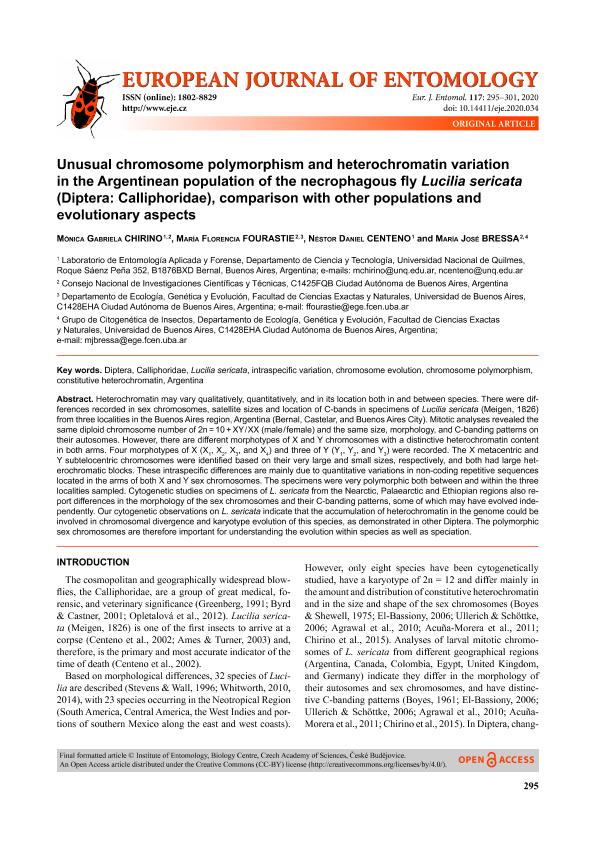Mostrar el registro sencillo del ítem
dc.contributor.author
Chirino, Monica Gabriela

dc.contributor.author
Fourastié, María Florencia

dc.contributor.author
Centeno, Néstor Daniel

dc.contributor.author
Bressa, Maria Jose

dc.date.available
2022-11-11T23:52:15Z
dc.date.issued
2020-07
dc.identifier.citation
Chirino, Monica Gabriela; Fourastié, María Florencia; Centeno, Néstor Daniel; Bressa, Maria Jose; Unusual chromosome polymorphism and heterochromatin variation in the Argentinean population of the necrophagous fly Lucilia sericata (Diptera: Calliphoridae), comparison with other populations and evolutionary aspects; Czech Academy of Sciences; European Journal of Entomology (Ceske Budejovice); 117; 7-2020; 295-301
dc.identifier.issn
1210-5759
dc.identifier.uri
http://hdl.handle.net/11336/177563
dc.description.abstract
Heterochromatin may vary qualitatively, quantitatively, and in its location both in and between species. There were differences recorded in sex chromosomes, satellite sizes and location of C-bands in specimens of Lucilia sericata (Meigen, 1826) from three localities in the Buenos Aires region, Argentina (Bernal, Castelar, and Buenos Aires City). Mitotic analyses revealed the same diploid chromosome number of 2n = 10 + XY / XX (male / female) and the same size, morphology, and C-banding patterns on their autosomes. However, there are different morphotypes of X and Y chromosomes with a distinctive heterochromatin content in both arms. Four morphotypes of X (X1, X2, X3, and X4) and three of Y (Y1, Y2, and Y3) were recorded. The X metacentric and Y subtelocentric chromosomes were identified based on their very large and small sizes, respectively, and both had large heterochromatic blocks. These intraspecific differences are mainly due to quantitative variations in non-coding repetitive sequences located in the arms of both X and Y sex chromosomes. The specimens were very polymorphic both between and within the three localities sampled. Cytogenetic studies on specimens of L. sericata from the Nearctic, Palaearctic and Ethiopian regions also report differences in the morphology of the sex chromosomes and their C-banding patterns, some of which may have evolved independently. Our cytogenetic observations on L. sericata indicate that the accumulation of heterochromatin in the genome could be involved in chromosomal divergence and karyotype evolution of this species, as demonstrated in other Diptera. The polymorphic sex chromosomes are therefore important for understanding the evolution within species as well as speciation.
dc.format
application/pdf
dc.language.iso
eng
dc.publisher
Czech Academy of Sciences

dc.rights
info:eu-repo/semantics/openAccess
dc.rights.uri
https://creativecommons.org/licenses/by-nc-sa/2.5/ar/
dc.subject
DIPTERA
dc.subject
CALLIPHORIDAE
dc.subject
LUCILIA SERICATA
dc.subject
INTRASPECIFIC VARIATION
dc.subject
CHROMOSOME POLYMORPHISM
dc.subject
CONSTITUTIVE HETEROCHROMATIN
dc.subject
ARGENTINA
dc.subject
CHROMOSOME EVOLUTION
dc.subject.classification
Otras Ciencias Biológicas

dc.subject.classification
Ciencias Biológicas

dc.subject.classification
CIENCIAS NATURALES Y EXACTAS

dc.title
Unusual chromosome polymorphism and heterochromatin variation in the Argentinean population of the necrophagous fly Lucilia sericata (Diptera: Calliphoridae), comparison with other populations and evolutionary aspects
dc.type
info:eu-repo/semantics/article
dc.type
info:ar-repo/semantics/artículo
dc.type
info:eu-repo/semantics/publishedVersion
dc.date.updated
2021-09-07T18:28:03Z
dc.journal.volume
117
dc.journal.pagination
295-301
dc.journal.pais
República Checa

dc.journal.ciudad
Ceske Budejovice
dc.description.fil
Fil: Chirino, Monica Gabriela. Universidad Nacional de Quilmes. Departamento de Ciencia y Tecnología. Laboratorio de Entomología Aplicada y Forense; Argentina. Consejo Nacional de Investigaciones Científicas y Técnicas; Argentina
dc.description.fil
Fil: Fourastié, María Florencia. Consejo Nacional de Investigaciones Científicas y Técnicas. Oficina de Coordinación Administrativa Ciudad Universitaria. Instituto de Ecología, Genética y Evolución de Buenos Aires. Universidad de Buenos Aires. Facultad de Ciencias Exactas y Naturales. Instituto de Ecología, Genética y Evolución de Buenos Aires; Argentina
dc.description.fil
Fil: Centeno, Néstor Daniel. Universidad Nacional de Quilmes. Departamento de Ciencia y Tecnología. Laboratorio de Entomología Aplicada y Forense; Argentina
dc.description.fil
Fil: Bressa, Maria Jose. Consejo Nacional de Investigaciones Científicas y Técnicas. Oficina de Coordinación Administrativa Ciudad Universitaria. Instituto de Ecología, Genética y Evolución de Buenos Aires. Universidad de Buenos Aires. Facultad de Ciencias Exactas y Naturales. Instituto de Ecología, Genética y Evolución de Buenos Aires; Argentina. Universidad de Buenos Aires. Facultad de Ciencias Exactas y Naturales. Departamento de Ecología, Genética y Evolución; Argentina
dc.journal.title
European Journal of Entomology (Ceske Budejovice)

dc.relation.alternativeid
info:eu-repo/semantics/altIdentifier/doi/http://dx.doi.org/10.14411/eje.2020.034
dc.relation.alternativeid
info:eu-repo/semantics/altIdentifier/url/https://www.eje.cz/artkey/eje-202001-0034_unusual_chromosome_polymorphism_and_heterochromatin_variation_in_the_argentinean_population_of_the_necrophagous.php
Archivos asociados
